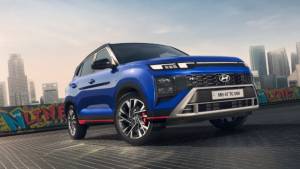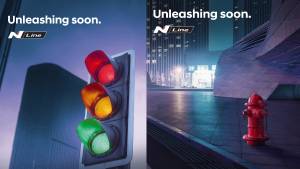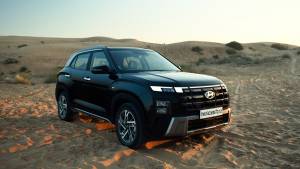Hyundai Creta quick drive review
Hyundai has finally showcased its new global SUV, the Creta. The Korean carmaker has now entered the competitive and fast growing segment for the first time. It's not a sub 4m vehicle and is a lot larger than the other compact SUVs like the EcoSport. This Hyundai competes with the Renault Duster and Nissan Terrano. The Creta is made in India and will be exported to various global markets. We've just seen the production version at the Hyundai plant in Chennai and got to drive it too.
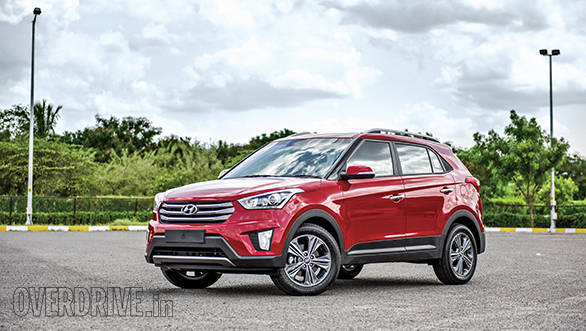
Design and styling
The Creta features the new nature inspired Fluidic Sculpture 2.0 design that has also been the design language seen on other modern Hyundais. In fact look at it head on and you will be reminded of the Santa Fe. This alone gets the SUV some extra brownie points note the similarity with the front hexagonal grille and the sharp well defined headlamps of the more premium Santa Fe. The headlamps also feature projector and day light running lamps and will be offered only in the top variants. Vertical inserts in the bumper house the fog lamps adding to the aggressive character. The A-pillar is blacked out and merges with the roof quite sharply. The window line runs upward and the entire side is flatter and less curvy than other Hyundai cars. The shoulder line however adds a lot of character, is well defined and runs parallel to the window line all the way to the tail lamps.
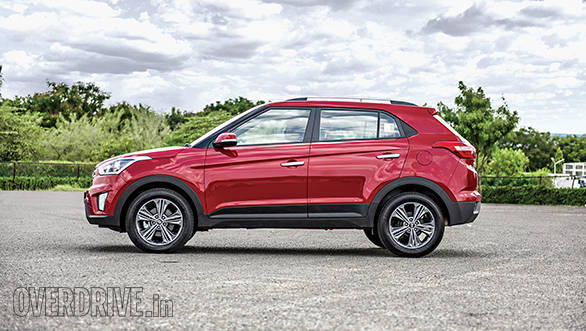
The fact that it's longer than 4 metres is obvious when viewed from the side. It's a proportionate design and the overall stance is quite dynamic. Side/ lower cladding and roof rails are typical of an SUV and these are offered in the Creta. The headlamps and tail lamps wrap-around well and are visible from the side. The top variants feature large 17-inch wheels that feature a striking five-spoke split design. The other variants will get a 16-inch wheel while the base model gets hub caps. The base variant gets a matte black grille, body coloured pillars and door handles. It won't even get roof rails.
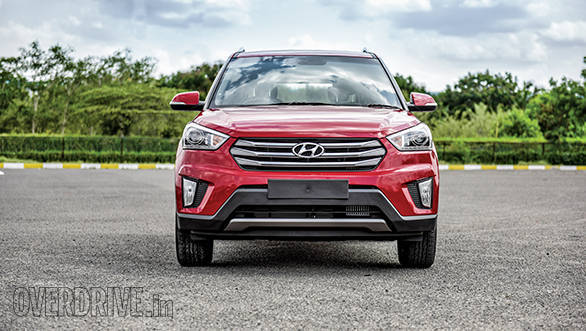
The rear end is smart too and goes well with the overall design. The split rear lamps look striking. LED lamps aren't offered but the LED-effect (seen in the i20) is present. The tailgate isn't loud and left uncluttered since the number plate is housed in between the upper tailgate section and the bumper. The top variant though gets a chrome number plate garnish that stands out more than required. The boot features a lower loading lip compared to its rivals. The bumper also features reflectors and other mock inserts to go with the SUV character. We noticed a few inconsistent panel gaps especially where the side cladding meets the doors. Overall, the design isn't loud like the Hyundais we are used to seeing but is actually modern and yet easy on the eye. It's a good looking SUV and has the potential to appeal to a wide audience.
Space and interior
Step inside the Creta and you will be impressed with the design, quality of materials used, features and most importantly space. The design is appealing, very SUV and car like at the same time. The dashboard also uses an edgy approach. The centre section is finished in beige while the rest of the interior is all-black. The centre screen is prominent since it's a large touchscreen unit. The air vents in the centre are vertically placed for better air flow. There are two 12V sockets provided (we expected to see three), one up front and one for the rear passengers. The door grab handles are like the ones seen in premium SUVs. We also noticed that a few parts have been lifted from the i20. This is a good thing since the hatchback scores high on quality. The steering wheel too uses the same controls seen in the Elite i20, however, the wheel design is similar to the older generation Hyundai i20 but still looks contemporary.
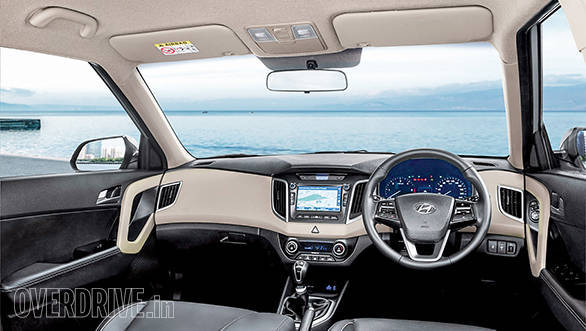
The interior is built well and features best in class quality and materials. There's a lot of storage spaces too - bottle holders on all doors and cup holders on the centre console. There are various other storage options too near the gear lever and in the door as well as the centre armrest. Missing however is a storage box on the top section of the dash.
The seats are comfortable and there's good support too. The driving position is car like but the seat height can be adjusted quite a bit for a more commanding position and view. At the back, the seats could offer more support. There is decent knee-room and ample headroom but accommodating three adults is a bit of a squeeze. The smaller rear window and the dark interior, however, makes it feel slightly claustrophobic. There is a rear armrest too that also features two cup holders. The floor however is almost fully flat. There is no all-wheel drive variant which helps in this regard. Boot space is impressive too and looks slightly larger in depth and width than the Duster. The rear seats tumble down to offer a flat loading bay.
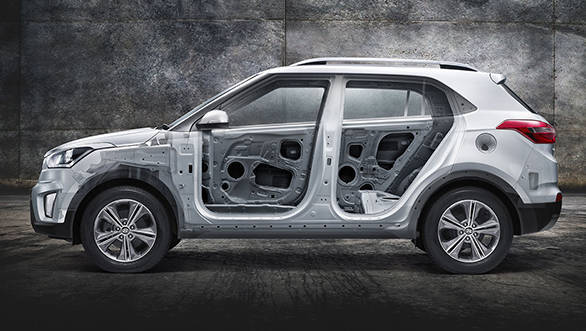
Engines
The Creta will be offered with three different engines (one petrol and two diesel variants) borrowed from the Verna. The 1.4-litre U2 CRDi produces 90PS while the 1.6-litre CRDi diesel that we briefly drove puts out 128PS. Both the engines produce as much power as the Verna. We are still not sure if the torque rating remains the same though. The petrol variant will only feature the 1.6-litre VTVT unit (also seen in the Verna).
Out on the road the 1.6-diesel is refined and is quick off the block, traction control is offered in the top variants and does intervene during hard acceleration and in between gear shifts when there is wheelspin. We however switched off traction control and found the SUV to be quite quick to hit the ton. Expect performance to be similar to the Verna - this will make it one of the quickest vehicles in the segment. The cabin is well insulated too and very little diesel clatter actually seeps in. Gear shifts are smooth and fall in place, like in the i20. The feel could have been better though - it's a little too soft for an SUV.
There's good news for automatic transmission lovers. The Creta is also offered with a torque converter mated to the 1.6-diesel (first in segment). We also drove this version which will only be available in the SX trim. The engine is capable and powerful but the gear shifts could have been quicker and smoother. There are no paddle shifters but one can still shift gears using the gear selection lever. The AT isn't as quick as the MT but will be ideal both in the city and on the highway.
Ride and handling
For an SUV, the ride and handling is actually impressive and more car like. It isn't a very heavy vehicle and doesn't feel like one around corners. There isn't much body roll and the Creta stays well planted ever at triple digit speeds. The steering isn't vague-feeling like the i20 and is well weighed, neither too heavy nor too soft, with good feedback. Around the Hyundai test track, the Creta was quite involving and fun to drive. There's no independent rear suspension on offer though, it uses a simpler torsion beam setup instead. While the automatic variant features a 16-inch wheel, the manual top variant runs on 17-inch units. Both feature 215-section Bridgestone rubber that offers good grip levels.
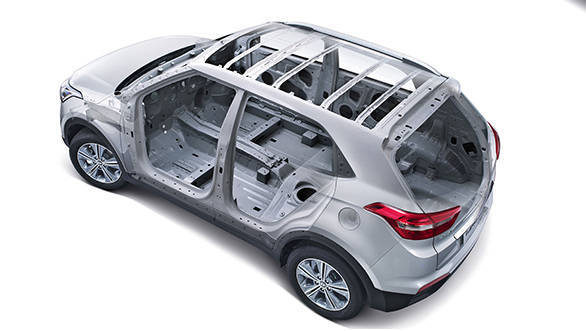
Ride quality? While we didn't drive over broken or rough surfaces, on smooth tarmac the ride was impressive and comfortable. The Creta offers a good balance between ride and handling. In fact we think it is one of the best handling vehicles in the Hyundai line-up today.
It isn't a hardcore off-roader though. There is ample ground clearance (we reckon it's close to the Duster at 210mm) but there is no AWD variant. There is no metal under body protection like in the Duster. Instead there's a flat panel that offers some protection and aids aerodynamics. Traction control is offered in the top variants and can be turned off.
Features
It's a Hyundai after all so as expected, there's a lot of comfort and safety features on offer. Apart from the features we've already spoken about, the top SX variant also gets an optional 7-inch stereo with navigation, six speakers (5-inch touchscreen unit is standard), static bending lights, leather seats, shark fin antenna, keyless entry and push button ignition, electric folding mirrors, rear AC vents, up to six airbags, reverse parking camera, ESC, VSM and hill assist control (in the automatic variant mostly).
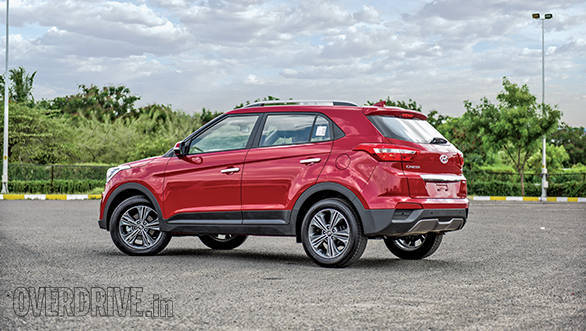
Price
The Creta is on sale now and is priced on par with its rivals (See our spec comparo for more details). Since there are a lot of variants on offer including the base petrol, the starting price for the base petrol is Rs 8.59 lakh (ex-Delhi). The more important diesel variants are priced between Rs 9.46 lakh and 13.6 lakh (all ex-showroom prices). The Hyundai Creta has impressed on many counts and definitely has all it takes to give the competition a very tough time. Come back here for a comprehensive first drive and road test very soon.
More from OVERDRIVE on the all-new Hyundai Creta:
Hyundai India launches the Creta at Rs 8.59 lakh
Image gallery: Hyundai Creta in India
Starts Rs 9.99 Lakhs
1353cc
Automatic
115
242
-NA-
Starts Rs 7.99 Lakhs
1498cc
Manual
100
215
21.7 Kmpl
Starts Rs 6.8 Lakhs
1493cc
Manual
83
241
-NA-
Starts Rs 8.39 Lakhs
1462cc
Automatic
105
138
18.55 Kmpl
Starts Rs 9.99 Lakhs
1461cc
Automatic
85
245
19.61 Kmpl
Starts Rs 8.49 Lakhs
1330cc
CVT
106
154
-NA-
